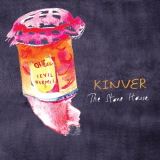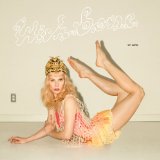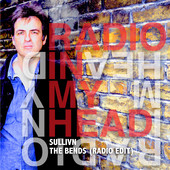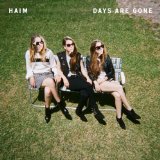 Well, this is certainly very different from most of the albums I’ve reviewed recently, apart from the Tess of the Circle album, “Thorns”. Kinver are Ian Parker (guitars and vocals), Beth Porter (cello and backing vocals), Alex Thomas (drums and percussion), Steve Amadeo (bass) and Morg Morgan (piano and Hammond) and they play the gentle, melodic and sometimes haunting songs of Ian Parker. If you’re after banging rhythms and loads of digital effects, then you’re in the wrong place; the arrangements of the songs on their debut, “The Stone House” are tasteful and subtle, demonstrating great technique without any hint of overplaying.
Well, this is certainly very different from most of the albums I’ve reviewed recently, apart from the Tess of the Circle album, “Thorns”. Kinver are Ian Parker (guitars and vocals), Beth Porter (cello and backing vocals), Alex Thomas (drums and percussion), Steve Amadeo (bass) and Morg Morgan (piano and Hammond) and they play the gentle, melodic and sometimes haunting songs of Ian Parker. If you’re after banging rhythms and loads of digital effects, then you’re in the wrong place; the arrangements of the songs on their debut, “The Stone House” are tasteful and subtle, demonstrating great technique without any hint of overplaying.
The songs are introspective, confessional folk/rock of the type that was incredibly popular in the early 70s. The opening track,” The Lights” sets the tone for the album with a cello riff (there’s a phrase I never thought I’d use) played over some clipped guitar chords as an intro before the song unfolds into a story of loss and redemption, common themes throughout the album. The gentle “The Will to Dance” leads into what is musically the bounciest track on the album, the almost-jaunty “From the Start”. “Ten Thousand” is a twenty-first century protest song wrapped up in a very gentle, laid-back style while “Silent Void” has a folky start and is probably the most confessional song on the album, but more about that later. “Turning to Light” starts with a military drum pattern, but soon drops into the familiar low-tempo band groove while “Waste in Chains” features a nice finger-picked guitar accompanied by cello, before dropping into a country-feel middle section, then back to guitar and cello. The gloomy “Lonelier Souls” acts as a contrast with the uptempo and lyrically upbeat “Basket” and with “Halfway Home”, the album closes as it opened with guitar, cello and viola.
Musically the album is pretty easy on the ear; the performances are very good throughout and the band move through a variety of styles with ease and Ian Parker has a very good voice, reminiscent at times of another West Midlander, Stephen Duffy. Lyrically, it isn’t such an easy listen. Ian Parker, as a lyricist, pulls out some interesting metaphors including this in “From the Start”: ‘It occurred to me you see that I’d never really be quite round enough for many of life’s holes’, but it’s the content overall that I’m less sure about.
I’m quite partial to a bit of melancholy, even misery, in my music but on “The Stone House” it’s almost inescapable. There’s an air of fragility which runs through each track on the album, in the music as well as the lyrics and a sense of alienation in the lyric above, but also in several references to misfits and addiction. The songs could have been sequenced to create a narrative of redemption (or the opposite) but we’re left guessing how the story actually ends. It’s difficult to tell if a song is confessional and based on biographical events, or a complete work of fiction but if “The Stone House” is based on reality, then I really hope that making the album has helped Ian Parker through a difficult time. If it’s a creation and not a confession, then it’s a very convincing portrait of a desperately difficult existence.
CD release Monday October 21
 Since recording her occasionally twee, but consistently charming self- titled debut from 2011, Danish electronic pop singer-songwriter Oh Land has been listening to a lot of rap and the influences of this genre can be heard all over the tight and tough follow up,” Wishbone”. The stark, attention-seeking cover portrait alone projects enough star power to confirm that Nanna Ohland Fabricius means business this time; just try not to stare at it. Along with the recruitment of David Sitek, TV on the Radio member and fast becoming the most inspired alt-pop producer to emerge after the last couple of years (Beck, Beady Eye, Yeah Yeah Yeahs and CSS), the promise of something both unexpected and immediately compelling is met almost without exception.
Since recording her occasionally twee, but consistently charming self- titled debut from 2011, Danish electronic pop singer-songwriter Oh Land has been listening to a lot of rap and the influences of this genre can be heard all over the tight and tough follow up,” Wishbone”. The stark, attention-seeking cover portrait alone projects enough star power to confirm that Nanna Ohland Fabricius means business this time; just try not to stare at it. Along with the recruitment of David Sitek, TV on the Radio member and fast becoming the most inspired alt-pop producer to emerge after the last couple of years (Beck, Beady Eye, Yeah Yeah Yeahs and CSS), the promise of something both unexpected and immediately compelling is met almost without exception.
“Wishbone” is Oh Land’s declaration of change and of the strength required to achieve it. Many of the songs use fighting or violent metaphors to get the message across, but are then off set against lush, warm restorative retreats. Album opener “Bird in An Aeroplane” is a strange, weary-sounding minor key, synth pile-up; it’s also a very good pop song but not fully realised on first listen. Like some of Sitek’s other productions, the fun is unravelling and exposing a song’s real intentions, which can sometimes take time. At the other end of the spectrum, “Renaissance Girls” furiously changes the tone with its scatty mania and staccato melody, Oh Land dazzling with exuberant vocals. It’s one of the most self-possessed pop songs of the year.
“Love a Man Dead”, “Kill My Darling” and, in particular, “My Boxer”, which sees Oh Land reunite with producer Dan Carey (MIA, Bat For Lashes and Kylie), form a trilogy of sorts of part-rapped, part-sung concise muscular electro pop tracks. David Sitek again changing musical tack with “Pyromaniac” which is loose and funky and with its celebratory woo-hoo’s is The Cardigan’s classic “Lovefool”’s older sister. The twinkling “Sleepy Town” and doomy, two note piano chime of “Next Summer “(‘Put me to sleep and don’t wake me up, until time has changed please let’s fast forward the clock’), both topped with deceptively sweet vocals, successfully take the theme of small town resentment and boredom into mid tempo territory along with the finger snapping r’n’b of “Cherry On Top”.
“Green Card” is a majestic, rolling Sia co-write and is a success of proportion and restraint; trumpets swell and Oh Land’s elaborate vocals demonstrate the skill and versatility of her vision and talent. The wheezy and dilapidated electronics on album closer “First to Say Goodnight” mimic more than anywhere else here the overall sonic atmosphere of Sitek’s successful collaboration with Scarlett Johansson on her album of Tom Waits covers “Anywhere I Lay My Head”. Where Johansson’s voice was never much more than a remote smudge or drawl, Oh Land’s clear and intimate vocals pull you much closer to the sentiment and sound beautiful alongside the ornate, drunken musicbox soundtrack.
Robyn, Lykke Li, Dragonette and Annie make vivid, revered and, to many, cultish pop music of various shades. Oh Land, like several similar acts, has been on the periphery of this greatness for a little while now but “Wishbone” sees her nudge her way into this very special group with an album that, in addition to cementing her own unique identity, is a delirious and thoughtful collection of pop beauty.
 Ready or not, here it comes. It’s the second single from the Radio (in my) Head project and this time it’s the turn of Sullivn putting their highly individual stamp on “The Bends”. The band are John O’Sullivan (all vocals), Layla MK Kim (piano), Simon Goudarzi (guitars), Sjur Opsal (bass) and Jon Mar Ossurarson (drums). Now, I have to be completely honest here and admit that despite loving Radiohead, I can take or leave the original of that particular song. In fact, I’d rather leave it; if you can imagine Tom Verlaine singing alternately stoned and constipated, that’s how I hear Thom Yorke’s vocal on “The Bends”.
Ready or not, here it comes. It’s the second single from the Radio (in my) Head project and this time it’s the turn of Sullivn putting their highly individual stamp on “The Bends”. The band are John O’Sullivan (all vocals), Layla MK Kim (piano), Simon Goudarzi (guitars), Sjur Opsal (bass) and Jon Mar Ossurarson (drums). Now, I have to be completely honest here and admit that despite loving Radiohead, I can take or leave the original of that particular song. In fact, I’d rather leave it; if you can imagine Tom Verlaine singing alternately stoned and constipated, that’s how I hear Thom Yorke’s vocal on “The Bends”.
This version is a very different beast, opening quietly and intimately with close-up solo vocal and piano before the guitars, bass and drums come thundering in at the end of the verse. The song, at different times, features funk elements, big distorted guitars, twin guitar parts, hints of late Beatles production and some subtle piano touches throughout. There is a tremendous attention to detail as the vocal sound moves from full and resonant to thin and distant and the guitars play power chords followed by atonal fills. You need to do two things to get the most out of this; play loud and repeatedly. Your neighbours won’t mind.
The B-side is a remix of Sullivn’s first single “Come Back”, taking the song down a very different route from the fairly straightforward ballad treatment of the original with a very trip-hop dubby feel of Massive Attack and Portishead and very heavy bass. It’s not quite full on Lee Perry dub, but there’s a lot on interesting things going on there. Possibly even better than the original single mix.
So what you get here is a Radiohead cover that’s packed with invention and great performances along with a cracking B-side. I only wish I liked the original more so I could really emphasise how much more I like this version . It’s available from Tuesday October 8 on iTunes.
 Haim are in a minority of artists who also form part of the majority where influences from chart music over the last thirty years can be heard clod-hopping all over their work but who are also pushing forward musically, and sound strikingly different from their current, retro-obsessed contemporaries. The three twenty-something sisters from LA write their own material and play their instruments, they aren’t an electronic act and neither do they aspire to be urban makeover superstars. But there are some fascinating deep and dark synths here and an R’n’B spirit is shadowing almost every song to the point where it does, albeit briefly, finally jump into the driving seat. “Tango in The Night”-era Fleetwood Mac, Prince, Sheryl Crow, The Police and eighties soft rock are the most dominant and easily-spotted influences for the Haim sisters debut though. Time and again you’ll hear these mentioned in reference to the group but importantly at the core of “Days Are Gone”, is a sound that is all theirs.
Haim are in a minority of artists who also form part of the majority where influences from chart music over the last thirty years can be heard clod-hopping all over their work but who are also pushing forward musically, and sound strikingly different from their current, retro-obsessed contemporaries. The three twenty-something sisters from LA write their own material and play their instruments, they aren’t an electronic act and neither do they aspire to be urban makeover superstars. But there are some fascinating deep and dark synths here and an R’n’B spirit is shadowing almost every song to the point where it does, albeit briefly, finally jump into the driving seat. “Tango in The Night”-era Fleetwood Mac, Prince, Sheryl Crow, The Police and eighties soft rock are the most dominant and easily-spotted influences for the Haim sisters debut though. Time and again you’ll hear these mentioned in reference to the group but importantly at the core of “Days Are Gone”, is a sound that is all theirs.
The first third of the album is home to all four heavily-promoted singles and with the possible exception of the worryingly Shania Twain tendencies of the overly-perky “The Wire” (not forgetting the Eagles “Heartache Tonight” drum intro – Ed), all still sound spring fresh, funky and with plenty of space for instruments and vocals to stretch out and sparkle. “If I Could Change your Mind” has a fidgety, skipping melody line which brings to mind freestyle electro pop from eighties artists like Cover Girls and Lisa Lisa, and the title track, a surprising co-write with UK new-house artist Jessie Ware, has plenty of tension and bustles along with an urgent agenda and rhythm.
It’s on the futuristic R’n’B of the oddly titled “My Song 5” where the band really surprise. If this were the lead single from Beyonce’s near-mythical, possibly forthcoming album or even more excitingly, another attempt at a comeback from Missy Elliott then either would be rightly lauded. Three seconds of dirgy, descending buzz bass and then massive slow pounding drums introduce vocals which mimic Wendy and Lisa doing their Purple Rain residence; dead eyed and dangerous, pitch black promising ‘honey I’m not your honey pie’. A dizzy and delirious middle eight where tight angelic harmonies flip forward and then just disappear and it’s one of the one of the most exciting and weird four minutes you’ll have experienced since the first time you heard “Get Ur Freak On”.
Continuing with the genuinely thrilling and experimental final third of “Days Are Gone” where the sound that we’d already heard from the band is both intensified and stripped away, “Go Slow” is a gorgeous and gently skulking “True Colours” but with all of the sonic fuzz wiped away. “Let Me Go” is the angriest sounding moment here, building from the sixties girl group chants in the dark into a tribal thud and clanking, dubby outro and “Running If you Call my Name” closes the album in a traditional way as a down-tempo mass of drums, guitars and those beautiful harmonies.
“Days Are Gone”, maybe more than anything else, is very welcome at this point in pop culture. Pop music is more female-driven and dominated than ever before; Gaga is eaten by Lana is eaten by Taylor is eaten by Miley. It happens so quickly and all have their place and merit but none sound like Haim. Image, although clearly very much considered, seems less of an issue to the group than the music itself, you can listen to the songs here and you don’t necessarily feel hijacked by a carefully constructed persona and brand as you may do when listening to “Born This Way” or “Video Games” say. This is a charismatic and superior release, real musical talent and love of performing that doesn’t sound cynical or short-sighted. Probably most satisfying of all, you can almost guarantee that this really is only the beginning for Haim and the best is still to come.
Out now.
 London-based duo and married couple Summer Camp’s 2011 “Welcome To Condale” debut was steeped in nostalgia and tomfoolery. A whole visual scrapbook was created to support the fictional town and characters of Condale with Jeremy Warmsley and Elizabeth Sankley referencing American pop culture with a specific decade, decided by them, that began in 1974. Musically it was enigmatic British indie pop circa 1988 but with built-in, up to the minute electronic dance flourishes occasionally bursting through. It was flawed but fascinating in equal proportions. Any modern trends sonic or otherwise have all but disappeared on this self-titled follow up and a more wistful and warm sound, still in love with a past, has taken its place. It’s the same band but in softer focus.
London-based duo and married couple Summer Camp’s 2011 “Welcome To Condale” debut was steeped in nostalgia and tomfoolery. A whole visual scrapbook was created to support the fictional town and characters of Condale with Jeremy Warmsley and Elizabeth Sankley referencing American pop culture with a specific decade, decided by them, that began in 1974. Musically it was enigmatic British indie pop circa 1988 but with built-in, up to the minute electronic dance flourishes occasionally bursting through. It was flawed but fascinating in equal proportions. Any modern trends sonic or otherwise have all but disappeared on this self-titled follow up and a more wistful and warm sound, still in love with a past, has taken its place. It’s the same band but in softer focus.
Lead single “Fresh” is a very old fashioned, massive string ‘old Hollywood’ sample on a loop. A retro dancer which brings to mind Spiller’s “Groovejet (If This Ain’t Love)” if it had been recorded 5 years earlier than its 2000 release. It’s very ‘musical’ and stands out because it’s so immediately familiar sounding and has one of the best melodies on the album. The first song “The End” is also a dance track of sorts; it certainly starts off with a substantial beat which gradually gets layered with various synth lines and trinkets, a clever middle eight and it’s indeed a strong opener. But Summer Camp’s real influences here are again more early 80’s jangly, electronic ‘kitchen sink’ melodic pop and not dance. Artists such as New Order and Altered Images can easily be heard and at worst the tweeness of Beautiful South comes to mind. The big beat wallop and rotating synth sample of “Crazy” is less Daft Punk and more early Fatboy Slim and it actually does sound dated, which I don’t think was ever the intention.
Stark and attention-seeking ballad “Fighters” certainly makes an impression. The lyrical metaphors are convincing (‘the first hit was hard and straight to the chin, a spray of blood caught his face as he leaned in, she staggered back in shock and surprise, shivered at the blow and tears welled in her eyes’) and Sankley’s plaintive vocals are beautifully recorded and right in your ear. But it also has the slight whiff of a school assembly musical which undermines the seriousness of the subject matter and takes away some of the much-needed weightiness; it sounds shallow when it should be sardonic. Flawed it may be but it is a definite glimpse into what they could be capable of and evidence of developing song writing skills. The sung -spoken “Phone Call” is a definite highlight and is reminiscent of late career Kirsty MacColl at her most melancholic and “Pink Summer” has pathos and an intimate and sad vocal delivery from Sankley. The swirling, dingy “I Got You” has a riff that sounds like Aneka’s 1981 novelty number one “Japanese Boy” but with little of that song’s energy or pop awareness, something the couple excelled at 2 years ago.
“Welcome to Condale” was uneven but had fantastic, eccentric peaks and whilst this is certainly a more cohesive collection of songs and themes, it fails to fully excite or divert from the whole pleasantness that prevails throughout. An enjoyable album certainly, but one where the duo’s intentions and a satisfying sense of a musical identity or presence is unclear. Influences may ring out loud and clear throughout and are fun to spot but Summer Camp’s own voice, and after much initial promise, is sadly less confident and idiosyncratic for the most part here.


